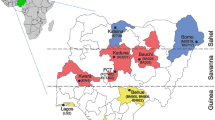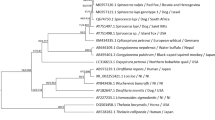Abstract
In the present work, a comparative morphological, biometrical and molecular study of Ctenocephalides spp. isolated from dogs (Canis lupus familiaris) from different geographical regions (Spain, Iran, and South Africa) has been carried out. The internal transcribed spacer 1 (ITS1) sequences of Ctenocephalides felis and Ctenocephalides canis collected from dogs from different geographical regions have been determined to clarify the taxonomic status of these species and to assess intraspecific variation and interspecific sequence differences. In addition, a phylogenetic analysis based on ITS1 sequences has been performed. Four different morphological populations were observed in the individuals of C. felis collected from dogs from different geographical locations. Nevertheless, the comparative study of the ITS1 sequences of the different morphological populations observed in C. felis did not show molecular differences. The results showed clear molecular differences between C. felis and C. canis and some specific recognition sites for endonucleases were detected between both species. Thus, BfrBI and DraI sites have diagnostic value for specific determination in C. felis. The phylogenetic tree based on the ITS1 sequences of C. felis and C. canis revealed that all the populations of C. felis from different geographical regions clustered together and separated, with high bootstrap values, from C. canis. We conclude that ITS1 region is a useful tool to approach different taxonomic and phylogenetic questions in Ctenocephalides species.




Similar content being viewed by others
References
Amin OM (1976) Host associations and seasonal occurrence of fleas from Southeastern Wiscosin mammals with observations on morphologic variations. J Med Entomol 13:179–192
Amin OM, Wells TR, Gately HL (1974) Comb variations in the cat flea, Ctenocephalides f. felis (Bouché). Ann Ent Soc Amer 67:831–834
Beaucournu JC, Launay H (1990) Les Puces (Siphonaptera) de France et du Bassin méditerranéen occidental. Faune de France, 76, Paris. Féd Franc Soc Sci Nat 548 pp
Beaucournu JC, Ménier K (1998) Le genre Ctenocephalides Stiles et Collins, 1930 (Siphonaptera, Pulicidae). Parasite 5:3–16
Bitam I, Dittmar K, Parola P, Whiting MF, Raoult D (2010) Fleas and flea-borne diseases. Int J Infect Dis 14:667–676
De Rojas M, Mora MD, Úbeda JM, Cutillas C, Navajas M, Guevara DC (2002) Phylogenetic relationships in rhinonyssid mites (Acari: Rhinonyssidae) based on ribosomal DNA sequences: insights for the discrimination of closely related species. Parasitol Res 88:675–681
De Rojas M, Ubeda JM, Cutillas C, Mora D, Ariza C, Guevara DC (2007) Utility of ITS1-5.8S-ITS2 and 16S mitochondrial DNA sequences for species identification and phylogenetic inference within the genus Rhinonyssus: the Rhinonyssus coniventris complex. Parasitol Res 100:1041–1046
Dobler G, Pfeffer M (2011) Fleas as parasites of the family Canidae. Parasite Vector 4:139
Dunnet GM, Mardon DK (1999) Siphonaptera, the insects of Australia: a textbook for students and research workers, 2nd edn. CSIRO and Melbourne University Press, Melbourne, pp 125–140
Durden LA, Hinkle NC (2009) Fleas (Siphonaptera). In: Mullen GR, Durden LA (eds) Medical and veterinary entomology, 2nd edn. Academic, San Diego, pp 115–135
Durden LA, Traub R (2002) Medical and veterinary entomology, vol. 7. Academic, San Diego, pp 103–125
Felsenstein J (1985) Confidence limits on phylogenies: an approach using the bootstrap. Evolution 39:783–791
Fox I (1952) Notes on the cat flea in Puerto Rico. AmJTrop Med Hyg 2:337–342
Gamerschlag S, Mehlhorn H, Heukelbach J, Feldmeier H, D’Haese J (2008) Repetitive sequences in the ITS1 region of the ribosomal DNA of Tunga penetrans and other flea species (Insecta, Siphonaptera). Parasitol Res 102:193–199
Gasser RB, Nansen P, Guldberg P (1996) Fingerprinting sequence variation in ribosomal DNA of parasites by DGGE. Mol Cell Probes 10:99–105
Gil Collado J (1949) Pulgas españolas parásitas de roedores. Rev Iber Parasitol 9:214–258
Gil Collado J (1960) Insectos y ácaros de los animales domésticos. Ed Salvat 20:305–325
Guindon S, Gascuel O (2003) A simple, fast, and accurate algorithm to estimate large phylogenies by maximum likelihood. Syst Biol 52:696–704
Holland GP (1949) The Siphonaptera of Canada. Can Dept Agric Tech Bul 70:1–306
Juckes TH, Cantor CR (1969) Evolution of protein molecules. Mammalian protein metabolism. Academic, New York, pp 21–132
Kaal JF, Baker K, Torgerson PR (2006) Epidemiology of flea infestation of ruminants in Libya. Vet Parasitol 141:313–318
Larkin MA, Blackshields G, Brown NP (2007) Clustal W and Clustal X version 2.0. Bioinformatics 23:2947–2948
Lewis RE (1972) Notes on the geographical distribution and host preferences in the order Siphonaptera. 1. Pulicidae. J Med Entomol 9:511–520
Lewis RE (1993) Notes on the geographical distribution and host preferences in the order Siphonaptera. Part 8. New taxa described between 1984 and 1990, with a current classification of the order. Entomol Soc Am 30:239–256
Linardi PM, Guimarâes LR (2000) Sifonápteros do Brasil. Sao Paulo: Museu de Zoologia USP/FAPESP
Linardi PM, Santos JLC (2012) Ctenocephalides felis felis vs Ctenocephalides canis (Siphonaptera:Pulicidae): some issues in correctly identify these species. Rev Bras Parasitol Vet 4:345–354
Medvedev SG (2002) Peculiarities of the distribution and host-associations of fleas (Siphonaptera). Entomol Obozr 81:737–753
Ménier K, Beaucournu JC (1998) Taxonomic study of the genus Ctenocephalides Stiles & Collins, 1930 (Insecta: Siphonaptera: Pulicidae) by using aedeagus characters. J Med Entomol 35:883–890
Rothschild M (1975) Recent advances in our knowledge of the order Siphonaptera. Annu Rev Entomol 20:241–259
Saitou N, Nei N (1987) The neighbor-joining method: a new method for reconstructing phylogenetic trees. Mol Biol Evol 4:406–425
Tamura K, Peterson D, Peterson N, Stecher G, Nei M, Kumar S (2011) MEGA5: molecular evolutionary genetics analysis using maximum likelihood, evolutionary distance, and maximum parsimony methods. Mol Biol Evol. doi:10.1093/molbev/msr121
Vobis M, D’Haese J, Mehlhorn H, Mencke N, Blagburn BL, Bond R, Denholm I, Dryden MW, Payne P, Rust MK, Schroeder I, Vaughn MB, Bledsoe D (2004) Molecular phylogeny of isolates of Ctenocephalides felis and related species based on analysis of ITS1, ITS2 and mitochondrial 16S rDNA sequences and random binding primers. Parasitol Res 94:219–226
Author information
Authors and Affiliations
Corresponding author
Rights and permissions
About this article
Cite this article
Marrugal, A., Callejón, R., de Rojas, M. et al. Morphological, biometrical, and molecular characterization of Ctenocephalides felis and Ctenocephalides canis isolated from dogs from different geographical regions. Parasitol Res 112, 2289–2298 (2013). https://doi.org/10.1007/s00436-013-3391-6
Received:
Accepted:
Published:
Issue Date:
DOI: https://doi.org/10.1007/s00436-013-3391-6




